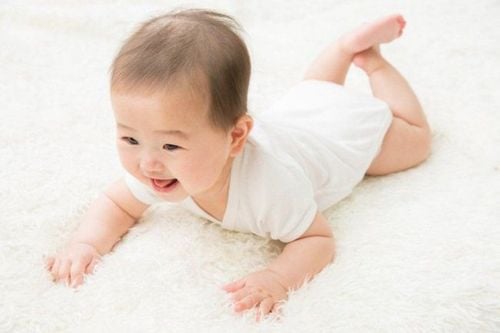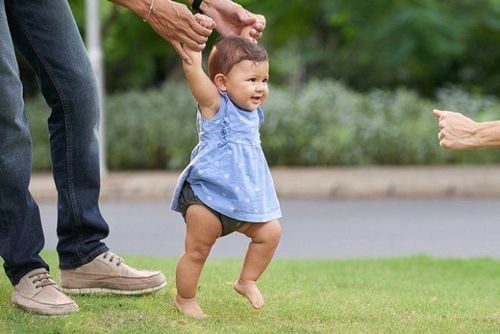This is an automatically translated article.
The article was consulted with Dr. Nguyen Thai Ngoc Chau - Neonatologist - Department of Pediatrics - Neonatology - Vinmec Phu Quoc International General Hospital.Newborns are objects of very rapid development, in which you will easily notice the surprising changes of children. The period from 4 to 12 months is one of those important milestones. Babies begin to crawl and babble, this is a milestone marking the child's communication with the surrounding environment.
1. Child development from 4 to 7 months old
1.1 Baby Milestones 4 to 7 Months During this time, infants begin to increase their expression and communication with the world around them. Your baby smiles, sometimes laughs out loud, and makes babble "conversations" with you. Around the same time, babies will also gradually develop the ability to move, although not much. At 7 months, your baby can roll over from a supine position to a prone position and back again. Children can also sit without parental assistance and moreover they can stand upright with partial support from parents. Babies can use their hands to grasp, scratch, pull objects close, and can hold toys and move them from hand to hand.Your baby's hearing and vision continue to develop, they will gradually become more sensitive to your voice and can pay attention to your stressed statements, for example when you say "no". At this point, the child also knows his or her name and will turn to look at you when you call.
The child can now see the world in color and the visible distances begin to grow farther. If you move a toy in front of your baby, he will direct his eyes and observe it with his eyes. Children also enjoy seeing themselves in the mirror.
1.2. Your baby's healthy development is partly due to the interactions he or she has with you, so get in on the game and things as you go along. play with baby. Show your baby smiles and cuddles, and communicate with them when they start babbling. This helps to encourage children's communication skills. Read a book together every day, naming objects you see in books and around you.
Give your child plenty of opportunities to reinforce new physical skills by helping them sit and immobilize safely, letting them play on both belly and back. Before your baby can crawl, be sure to keep them indoors and keep the environment safe for them to explore.
Provide a variety of age-appropriate toys and household objects (like wooden spoons or cardboard boxes) for your baby to explore. You should establish a timetable for your child, from which you can form good habits about sleeping, feeding and playing.
By 6 months, your baby may be ready to start learning solid foods.

There are signs of muscle spasticity or flaccid muscles; The muscles in the neck are not strong enough to hold the baby's head in place; Unable to sit without assistance; No response to noise or pleasure; Not affectionate with those closest to them; No interest in toys.
2. Child development from 8 to 12 months old
2.1. Baby Developmental Milestones Between 8 and 12 months, babies can now be said to be eager explorers. You may be surprised how much more and further your child can move around the house. The baby can now crawl or walk competently. By 12 months, babies can fully sit and cling to anything they can to pull themselves up to stand and move. Babies can even take some of their first steps without help before their first birthday.Baby babbles can now be heard more clearly out loud, more like real conversation, and you'll hear your baby's first words - usually "mama" or "dada." Before long, children will be able to say simple phrases, but in the meantime they can use gestures to indicate what they want or don't want and they are easily attracted, attentive and listening to words. your more.
Children's hands-on ability is increasingly agile. Children enjoy putting things in their own containers and taking them out again. Babies can use their fingers to hold food and toys. Subtle movements will gradually improve. Your baby loves to be just like you by combing his own hair, drinking from a cup, and pretending to talk on the phone.
Although the child may seem extroverted, perhaps at this time he is still quite reserved with strangers. And when you're away from your child, he or she may become anxious about the absence of loved ones. However, this is normal at this age.

As children become more active, it is important to provide a safe space to help explore. He may not be able to walk yet, but you can support him by holding him in your arms and putting his feet in contact with the floor so he can feel his first steps. When your child is more stable you can let him lean on the sofa or
Pay attention to what he likes and give him the freedom to use all his senses to play and explore. Give your child crayons and paper, stacking blocks, empty food containers, and pots and pans to play with.
Praise and reward good behaviors. If your child is being too naughty, keep your attitude brief, for example, just say "no" and shift the child's attention elsewhere. Even though your child is too young to understand and follow the rules, you can start showing him what behaviors are not allowed and help him find activities that are more appropriate.
Respect separation anxiety: Build trust by giving your child time to get to know new caregivers and always say goodbye before you leave.
2.3. Danger signs to watch out for between 8 and 12 months of age. Each child develops at his or her own pace, but talk to your child's doctor if your child:
Doesn't crawl at this point; The child can give up, but one side has a weak feeling and the movement of the hands is uneven; Unable to stand despite support; Dissatisfied with his toys; Don't say any words; Don't use gestures, such as shaking your head "no" and pointing at objects your child wants. When your baby shows signs of abnormality in movement, language, cognition, emotions.... you should take your baby to see a specialist doctor for early examination and consultation. As a key area of Vinmec Medical system, Pediatrics Department is well invested in personnel, technology and equipment, bringing satisfaction to customers.

Please visit Vinmec.com website regularly and update useful information to take care of your baby and family.
Please dial HOTLINE for more information or register for an appointment HERE. Download MyVinmec app to make appointments faster and to manage your bookings easily.
Reference source: babycenter.com













